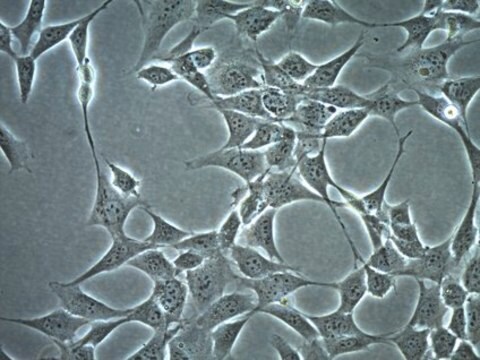SCC199
HGT-1 Human Gastric Cancer Cell Line
Faça loginpara ver os preços organizacionais e de contrato
About This Item
Código UNSPSC:
41106514
eCl@ss:
32011203
NACRES:
NA.45
Produtos recomendados
descrição
Cell line type: Cancer Cells
técnica(s)
cell culture | mammalian: suitable
Descrição geral
Gastric adenocarcinoma is the most common type of gastric cancer, representing 95% of malignancies that originate in the stomach (1). The incidence of gastric adenocarcinoma is especially high in Central and Eastern Asia and areas of Eastern Europe and South America, comprising a significant global health burden (1). Robust models of gastric cancer that reflect the most prevalent form of this disease are therefore highly valuable.
References:
1. Nat Rev Dis Primers 2017; 3: 17036.
2. Cancer Res 1982; 42(4): 1541-1548.
References:
1. Nat Rev Dis Primers 2017; 3: 17036.
2. Cancer Res 1982; 42(4): 1541-1548.
The HGT-1 human gastric cancer cell line is derived from a poorly-differentiated adenocarcinoma and is well-established as a model for studies of gastric cancer and mechanisms of gastric secretion. HGT-1 cells are tumorigenic in nude mice and have a hyperdiploid karyotype (2). HGT-1 cells do not secrete mucus, yet maintain expression of functional histamine H2 receptors also found in normal acid-secreting parietal cells (2).
Source:
The HGT-1 cell line was established from a primary tumor of a 60-year-old male patient (2).
Source:
The HGT-1 cell line was established from a primary tumor of a 60-year-old male patient (2).
Aplicação
This product is sold solely for research use per the terms of the “Restricted Use Agreement” which govern its use as detailed in the product Data Sheet or Certificate of Analysis. For information regarding any other use, please contact licensing@emdmillipore.com.
Qualidade
- Each vial contains >=1X106 viable cells.
- Cells are tested negative for infectious diseases by a Human Essential CLEAR panel by Charles River Animal Diagnostic Services.
- Cells are verified to be of human origin and negative for inter-species contamination from rat, mouse, chinese hamster, Golden Syrian hamster, and non-human primate (NHP) as assessed by a Contamination CLEAR panel by Charles River Animal Diagnostic Services.
- Cells are negative for mycoplasma contamination.
- Each lot of cells is genotyped by STR analysis to verify the unique identity of the cell line.
Armazenamento e estabilidade
Store in liquid nitrogen. The cells can be cultured for at least 10 passages after initial thawing without significantly affecting the cell marker expression and functionality.
Exoneração de responsabilidade
Unless otherwise stated in our catalog or other company documentation accompanying the product(s), our products are intended for research use only and are not to be used for any other purpose, which includes but is not limited to, unauthorized commercial uses, in vitro diagnostic uses, ex vivo or in vivo therapeutic uses or any type of consumption or application to humans or animals.
Código de classe de armazenamento
12 - Non Combustible Liquids
Classe de risco de água (WGK)
WGK 2
Ponto de fulgor (°F)
does not flash
Ponto de fulgor (°C)
does not flash
Certificados de análise (COA)
Busque Certificados de análise (COA) digitando o Número do Lote do produto. Os números de lote e remessa podem ser encontrados no rótulo de um produto após a palavra “Lot” ou “Batch”.
Já possui este produto?
Encontre a documentação dos produtos que você adquiriu recentemente na biblioteca de documentos.
Nossa equipe de cientistas tem experiência em todas as áreas de pesquisa, incluindo Life Sciences, ciência de materiais, síntese química, cromatografia, química analítica e muitas outras.
Entre em contato com a assistência técnica